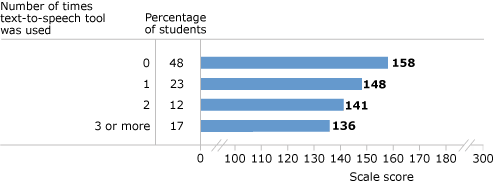The number of key presses represents each key stroke that students made in the process of completing their response to the writing prompt. It does not represent the number of words students wrote or how long their responses were (note that backspace and delete were counted as key presses). It is reasonable, however, to assume some relationship between the number of key presses and the length of the response.

Students who made more key presses to create their response scored higher on average than students who made fewer key presses.

Seventy-two percent of eighth-grade students made between 1,001 and 3,000 key presses, and 21 percent made 3,001 or more key presses in creating their response on the 2011 writing assessment.
Percentage of students and average scores in eighth-grade NAEP writing, by the number of key presses they made during the assessment: 2011
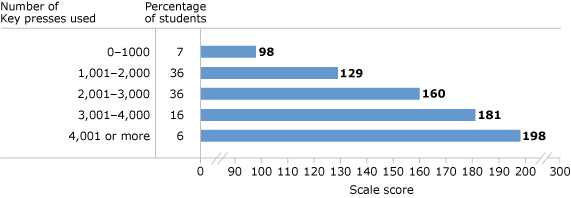

Fifty-one percent of twelfth-grade students made between 1,001 and 3,000 key presses, and 47 percent made 3,001 or more key presses in creating their response on the 2011 writing assessment.
Percentage of students and average scores in twelfth-grade NAEP writing, by the number of key presses they made during the assessment: 2011
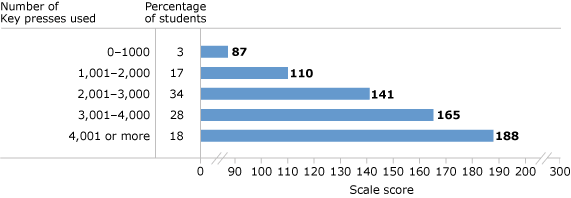
Backspacing serves as an editing tool that students may use to modify their writing. Students who used the backspace key more frequently scored higher on average than those who used it less often.

Forty-five percent of eighth-grade students used the backspace key between 101 and 300 times in writing their response, and 19 percent used it 501 or more times.
Percentage of students and average scores in eighth-grade NAEP writing, by the number of times they used the backspace key during the assessment: 2011
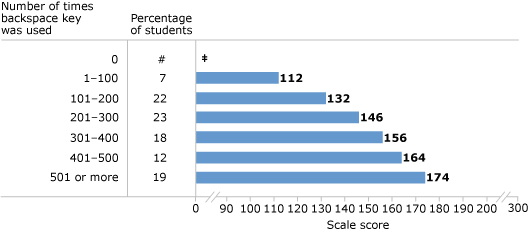

Twenty-nine percent of twelfth-grade students used the backspace key between 101 and 300 times in writing their response, and 36 percent used it 501 or more times.
Percentage of students and average scores in twelfth-grade NAEP writing, by the number of times they used the backspace key during the assessment: 2011
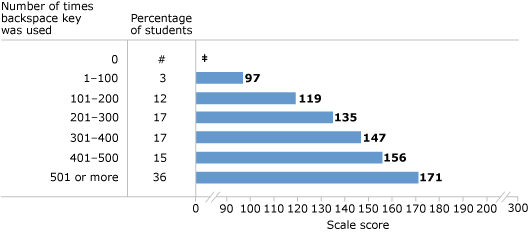
Producing written responses using word-processing software gives students access to editing tools such as a thesaurus to help enhance or improve their writing. Students who accessed the thesaurus more frequently scored higher on average than those who used it less often.

Twenty-nine percent of eighth-grade students accessed the thesaurus tool one or more times in the process of completing their response.
Percentage of students and average scores in eighth-grade NAEP writing, by the number of times they accessed the thesaurus tool during the assessment: 2011


Thirty-one percent of twelfth-grade students accessed the thesaurus tool one or more times in the process of completing their response.
Percentage of students and average scores in twelfth-grade NAEP writing, by the number of times they accessed the thesaurus tool during the assessment: 2011

Data for student actions regarding the use of spell-checking tools were collected in one of two ways: students could access the spell-check tool by clicking on a spell-check icon, or they could right-click on a word identified as misspelled to access spelling options. Data for the right-click option are provided below.
 Forty-four percent of eighth-grade students used the right-click option to access the spell-check tool between 1 and 10 times; those students scored higher on average than students who did not engage in the action at all, or who did so 11 or more times. In addition, students who used the action 11 or more times scored higher than students who did not use this tool at all.
Forty-four percent of eighth-grade students used the right-click option to access the spell-check tool between 1 and 10 times; those students scored higher on average than students who did not engage in the action at all, or who did so 11 or more times. In addition, students who used the action 11 or more times scored higher than students who did not use this tool at all.
Percentage of students and average scores in eighth-grade NAEP writing, by the number of times students used the spell-check (right-click option) tool during the assessment: 2011


Sixty percent of twelfth-grade students used the right-click option to access the spell-check tool between 1 and 10 times; those students scored higher on average than students who did not engage in the action at all, or who did so 11 or more times.
Percentage of students and average scores in twelfth-grade NAEP writing, by the number of times students used the spell-check (right-click option) tool during the assessment: 2011

Students could use a text-to-speech tool that allowed them to hear the writing prompt read aloud by a speech synthesizer program (it was not available to use on their own written responses). Students who used the text-to-speech tool more frequently scored lower on average than those who engaged in the action less frequently.

At grade 8, a total of 71 percent of students used the text-to-speech tool for the writing prompt one or more times and 29 percent did not use it at all.
Percentage of students and average scores in eighth-grade NAEP writing, by the number of times text-to-speech tool was used during the assessment: 2011
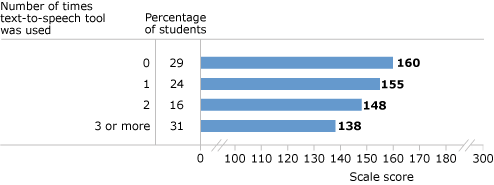

At grade 12, a total of 52 percent of students used the text-to-speech tool for the writing prompt one or more times and 48 percent did not use it at all.
Percentage of students and average scores in twelfth-grade NAEP writing, by the number of times text-to-speech tool was used during the assessment: 2011
